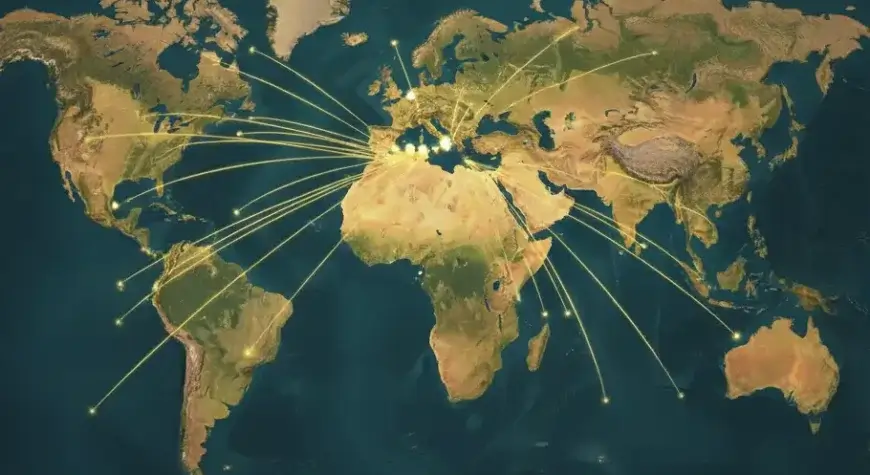The Spread of Islam: How Islam Expanded from Arabia to the World

The spread of Islam throughout the world is one of the most significant and transformative movements in human history. From its humble beginnings in the 7th century in the Arabian Peninsula, Islam grew to become a global religion with over 1.8 billion followers, making it the second-largest religion after Christianity.
The expansion of Islam was not a single event but a series of complex processes shaped by conquest, trade, missionary activity, and cultural exchange. This journey is not just about the spread of a religion—it’s about the intermingling of ideas, cultures, and civilizations that have deeply influenced human history.
The Birth of Islam: A Revolutionary Beginning
The Revelation and Message
In the early 7th century, Prophet Muhammad (peace be upon him), born in Mecca in 570 CE, began receiving revelations from Allah through the angel Gabriel. These divine messages were later compiled into the Quran, the holy book of Islam.
Muhammad’s message was revolutionary—he preached:
- The oneness of God (Tawheed)
- Social justice and equality
- Compassion for the poor and oppressed
His teachings challenged the socio-economic power of Meccan elites, leading to strong opposition and persecution.

The Hijra: A Turning Point
In 622 CE, Muhammad and his followers migrated to Medina, an event known as the Hijra, marking the beginning of the Islamic calendar. From Medina, Islam spread rapidly through both peaceful preaching and strategic defense.
By the time of the Prophet’s passing in 632 CE, Islam had established a firm foundation across the Arabian Peninsula.
The Early Expansion: The Rashidun Caliphate
After the Prophet’s death, leadership passed to his successors, the Caliphs. The first four—Abu Bakr, Umar, Uthman, and Ali (RA)—are known as the Rashidun Caliphs.
Conquests and Expansion
Under their leadership, the Islamic Empire expanded swiftly into the territories of:
- The Byzantine Empire
- The Persian Empire
Religious Tolerance
Although military conquest played a role, Islam’s spread was not achieved by force alone. Many conquered regions—such as Egypt, Syria, and Persia—were already familiar with monotheism through Christianity and Judaism, making them more receptive to Islam.
Moreover, the new Islamic rule allowed Jews and Christians (“People of the Book”) to freely practice their faith in return for modest taxation and loyalty to the state.
The Role of Trade and Cultural Exchange
While military conquest played a significant role in the spread of Islam, trade was equally important. Islamic merchants were among the most active traders in the world, particularly in regions such as North Africa, Central Asia, and Southeast Asia. Through the Silk Road, the Indian Ocean trade routes, and other networks, Islam spread peacefully to regions far from the Arabian Peninsula.

In places like West Africa, Southeast Asia, and the Indian subcontinent, Islam was often introduced through the influence of traders, scholars, and Sufis—Islamic mystics who emphasized a personal, spiritual connection with God. Sufis played a particularly crucial role in the spread of Islam in regions like Sub-Saharan Africa and Southeast Asia, where their inclusive approach to religious practice and their emphasis on peace and devotion made the faith more accessible and appealing.
In the 9th and 10th centuries, Muslim merchants brought Islam to the coastal regions of East Africa, where it mingled with indigenous African traditions and played a role in the development of the Swahili Coast. Similarly, Muslim traders brought Islam to the Malay Archipelago, where it took root and flourished in present-day Indonesia, Malaysia, and the Philippines.
The Golden Age of Islam: A Cultural Renaissance
The spread of Islam also facilitated a cultural and intellectual renaissance that spanned several centuries. During the Abbasid Caliphate (750–1258 CE), Baghdad became a center of learning and scholarship. The Islamic world was a melting pot of cultures, with scholars from various parts of the empire contributing to advancements in fields like mathematics, astronomy, medicine, philosophy, and engineering.
The famous House of Wisdom in Baghdad became a hub where scholars translated Greek, Persian, and Indian texts into Arabic, preserving and expanding upon ancient knowledge.

This intellectual flowering had a lasting impact on Europe, particularly during the Middle Ages. The works of Islamic scholars were eventually translated into Latin and had a profound influence on the Renaissance. The Islamic world was not just a political or religious entity; it was a beacon of intellectual and cultural achievement that shaped the course of global history.
The Spread to Sub-Saharan Africa and Southeast Asia
West Africa: Trade and Kingdoms
Islam entered West Africa through Saharan trade routes connecting the region to North Africa. Great empires like:
- Ghana
- Mali
- Songhai
embraced Islam—often starting with the elite classes before spreading gradually among the common people.
Southeast Asia: The Peaceful Expansion
By the 13th century, Islam had reached Indonesia and Malaysia through trade and missionary work.
Powerful Islamic states like the Sultanate of Malacca became centers of faith, learning, and diplomacy.
The Impact of Colonialism and the Modern Spread of Islam
In the 19th and 20th centuries, the colonial expansion of European powers significantly impacted the spread of Islam. While colonial rulers often sought to suppress indigenous cultures and religions, the Muslim population in colonies such as India, North Africa, and Southeast Asia grew, partly due to the spread of Islamic education and missionary activity.
The decline of colonial empires in the mid-20th century gave rise to new nations, many of which were predominantly Muslim. In the modern era, migration, globalization, and the spread of communication technologies have contributed to the further spread of Islam. Muslim communities can now be found in nearly every corner of the globe, from the United States to China, from Russia to sub-Saharan Africa.
A Global Faith: The Diversity of Islam Today
Today, Islam thrives in diverse environments:
- From the deserts of Arabia to the skyscrapers of Indonesia
- From African villages to European metropolises
Despite cultural and linguistic differences, Muslims share the same core beliefs:
- Oneness of God (Allah)
- Prophethood of Muhammad (PBUH)
- The Quran as final revelation
- The Five Pillars of Islam
Islam’s adaptability has allowed it to grow across civilizations while maintaining its essence of justice, mercy, and compassion. It continues to evolve, uniting people through faith, community, and moral purpose.
he spread of Islam is not merely a historical tale—it’s an ongoing story of faith, culture, and human connection. From Mecca to the farthest corners of the world, Islam has shaped civilizations and inspired countless individuals to live with purpose, compassion, and belief in one Creator.
Even today, the journey of Islam continues to unfold, reminding humanity of its shared roots, values, and the timeless message of peace that Prophet Muhammad (PBUH) brought to the world.
Read More : Muslim Scientists Who Shaped the World
Lorem Ipsum

